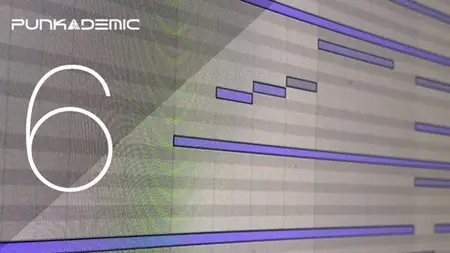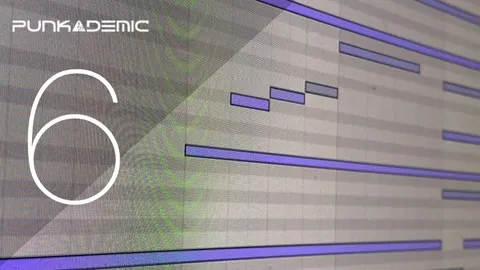Music Theory For Electronic Musicians 6: Advanced Harmony
Published 10/2024
MP4 | Video: h264, 1920x1080 | Audio: AAC, 44.1 KHz
Language: English | Size: 1.81 GB | Duration: 2h 55m
Published 10/2024
MP4 | Video: h264, 1920x1080 | Audio: AAC, 44.1 KHz
Language: English | Size: 1.81 GB | Duration: 2h 55m
Master complex harmony: From extended chords to weird progressions… the spice that makes electronic music fascinating.
What you'll learn
Craft sophisticated harmonies using 9ths, 11ths, and 13ths - the spices that make modern tracks pop
Master an encyclopedia of "weird chords" from the Hendrix chord to the "nu-disco special"
Understand when and why to use complex harmony in electronic music production
Learn voice leading and chord voicing techniques that add professional polish
Apply advanced harmony concepts to create distinctive, emotion-rich productions
Requirements
Completion of Music Theory for Electronic Musicians Parts 1-5 (or equivalent knowledge)
Basic understanding of scales, chords, and progressions
Any DAW with MIDI capability (demonstrations use Ableton Live)
A willingness to expand your harmonic vocabulary
Description
Welcome to Advanced Harmony, the sixth installment in the Music Theory for Electronic Musicians series. If you've mastered the fundamentals from Parts 1-5, you're ready to expand your harmonic spice rack with the sophisticated flavors that make contemporary electronic music truly distinctive.Think of this course as your advanced cookbook for harmony. We'll move beyond the salt-and-pepper basics of major and minor chords into a rich world of extended harmonies, exploring how modern producers use 9ths, 11ths, and 13ths to create those ear-catching moments in nu-disco, advanced EDM, and contemporary electronic genres.As the author of "Music Theory for Electronic Music Producers" and instructor to over 1 million students worldwide, I'll guide you through:A comprehensive encyclopedia of "weird chords" - from the iconic Hendrix chord to contemporary classicsAdvanced voicing techniques that add sophistication to your productionsPractical applications of extended harmony in modern electronic genresThe "when and why" of complex harmony - understanding the emotional impactProfessional-level harmony techniques used in nu-disco and contemporary productionThis course includes hands-on demonstrations in the MIDI grid, real-world musical examples, and practical applications for:Extended chord vocabulary (9ths, 11ths, 13ths)Voice leading and chord voicingTension and resolution in complex harmonyCreative chord substitutionsAdvanced harmonic progressionsEach concept is demonstrated in context, showing you exactly how these advanced techniques are used in contemporary electronic music production.Remember: Just as a chef needs to understand basic cooking before creating complex dishes, you'll need the foundational knowledge from Parts 1-5 to fully benefit from these advanced concepts. This course builds directly on that knowledge to elevate your production skills to professional levels.Join me for this deep dive into advanced harmony, and discover how to create those sophisticated, emotionally compelling moments that set professional productions apart.
Overview
Section 1: Introduction
Lecture 1 Introduction
Lecture 2 Tools We Will Use
Lecture 3 How Best to Use this Class
Section 2: Ninth Chords
Lecture 4 Characteristics of a 9th Chord
Lecture 5 The Minor Ninth
Lecture 6 The Major Ninth
Lecture 7 The Dominant Ninth
Lecture 8 The Dominant Minor Ninth
Lecture 9 The Dominant 7th (Sharp 9)
Lecture 10 The 6/9 & Minor 6/9 Chords
Lecture 11 The Major & Minor add9 Chords
Lecture 12 Have you Found the Pattern?
Section 3: Eleventh Chords
Lecture 13 Characteristics of the 11th Chord
Lecture 14 The Minor 11th Chord
Lecture 15 The Major 11th Chord
Lecture 16 The Dominant 11th Chord
Lecture 17 The Dominant (Sharp 11) Chord
Lecture 18 The Major 9 (Sharp 11) Chord
Section 4: Thirteenth Chords
Lecture 19 Characteristics of 13th Chords
Lecture 20 The Minor 13th Chord
Lecture 21 The Major 13th Chord
Lecture 22 The Dominant 13th Chord
Lecture 23 Lots of Variations on 13th Chords
Lecture 24 Can we go Higher? We about 15ths, 17ths, and 19ths?
Lecture 25 Let's Listen and Study These Chords
Lecture 26 [DOWNLOAD] Here is that file full of chords.
Section 5: Voicings, Voice Leadings, and Inversions
Lecture 27 First, Some Definitions
Lecture 28 Avoiding Root Voicings
Lecture 29 How Many Notes do you Need in a Chord?
Lecture 30 The Chord Voicing Challenge
Lecture 31 Playing with Voicings
Lecture 32 {DOWNLOAD] MIDI File of these Voicings
Section 6: A Whole Bunch of Super Weird Chords for Your Enjoyment
Lecture 33 Warning: These Chords don't Follow the Rules
Lecture 34 Fractional Chords
Lecture 35 Can you have two Chords at Once?
Lecture 36 The Oddly Powerful Half-Diminished Seven Chord
Lecture 37 The Even More Oddly Powerful Fully-Diminished Seven Chord
Lecture 38 The Neapolitan Chord
Lecture 39 The Italian 6 Chord
Lecture 40 The French 6 Chord
Lecture 41 The German 6 Chord
Lecture 42 The Elektra Chord
Lecture 43 The Rite of Spring Chord
Lecture 44 The Petrushka Chord
Lecture 45 The Bridge Chord
Lecture 46 The Hendrix Chord
Lecture 47 Many, Many, more.
Lecture 48 [DOWNLOAD] Here is that file!
Section 7: Using These Chords
Lecture 49 How do I know when to use these?
Lecture 50 If I'm using 7ths, do all of my chords have to be 7ths?
Lecture 51 Chord Density
Lecture 52 Transition Chords & Pivot Chords
Lecture 53 Outer Voices and Inner Voices
Lecture 54 Chord Rhythm
Section 8: The Final, Most Important, Biggest Secret About Harmony That I've Learned
Lecture 55 How to Pick the Best Chord Every Time
Lecture 56 [DOWNLOAD] Here is that Session!
Section 9: Wrap Up
Lecture 57 What Comes Next?
Lecture 58 Thanks for Watching!
Lecture 59 Bonus Content
Graduates of Music Theory for Electronic Musicians Parts 1-5 ready to take their productions to the next level,Anyone who's mastered basic chords but finds themselves asking "why do some tracks sound so much richer?",Electronic producers looking to add sophisticated harmonic elements to their tracks,Nu-disco, EDM, and electronic producers seeking that professional polish in their harmonies,Musicians who understand basic theory but want to explore the "jazz-like" harmony in modern electronic genres



